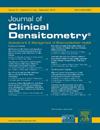Relationship of Skeletal Muscle Mass, Length of Sports Experience, and Sexual Maturity with Bone Density and Geometry in Adolescent Athletes
IF 1.6
4区 医学
Q4 ENDOCRINOLOGY & METABOLISM
引用次数: 0
Abstract
Objective: To identify the relationship between length of sports experience, muscle mass, and sexual maturity with bone mineral density (BMD) and geometry in adolescent basketball and track and field athletes.
Method: The study included adolescent (11–18 years) athletes, of both sexes, who practiced basketball (n = 26) or track and field (n = 24). Skeletal muscle mass was measured by bioelectrical impedance analysis. Data on sports training and sexual maturity were collected through a questionnaire. Total body, lumbar, femoral, and forearm BMD were determined by dual-energy X-ray absorptiometry. Femoral scans were used to generate bone geometry measurements (femur strength index, cross-sectional area, cross-sectional moment of inertia, section modulus, and buckling ratio). Bone outcomes were compared between modalities by the Mann–Whitney U-test or Student's t-test and by analysis of covariance with adjustment for sports experience, sexual maturity, and skeletal muscle mass.
Results: In the crude analysis, the basketball group had higher mean values for height, body weight, muscle mass, femoral neck BMD, cross-sectional area, and cross-sectional moment of inertia. In the covariate-adjusted analysis, the track and field group had higher total-body-less-head (0.995 vs. 1.035, p = 0.043), lumbar (1.012 vs. 1.107, p = 0.005), and radial (0.734 vs. 0.800, p = 0.005) BMD. Muscle mass was the main covariate influencing bone parameters, followed by sexual maturity.
Conclusion: Skeletal muscle mass was the main determinant of bone outcomes in adolescent athletes, followed by sexual maturity, underscoring the importance of considering these variables when assessing bone health in this population.
青少年运动员骨骼肌质量、运动经验长度和性成熟程度与骨密度和几何形状的关系。
目的:探讨青少年篮球、田径运动员运动经历长度、肌肉量、性成熟程度与骨密度和几何形状的关系。方法:研究对象为青少年(11-18岁)篮球运动员(n = 26)和田径运动员(n = 24),男女不限。采用生物电阻抗法测定骨骼肌质量。通过问卷调查收集运动训练和性成熟的数据。采用双能x线骨密度仪测定全身、腰椎、股骨和前臂骨密度。股骨扫描用于生成骨几何测量(股骨强度指数、横截面面积、横截面惯性矩、截面模量和屈曲比)。通过Mann-Whitney u检验或Student’st检验,通过协方差分析,调整运动经验、性成熟和骨骼肌质量,比较不同模式的骨骼结果。结果:在粗分析中,篮球组的身高、体重、肌肉质量、股骨颈骨密度、横截面积和横截惯性矩的平均值较高。在协变量调整分析中,田径组有更高的全身-头部(0.995比1.035,p = 0.043)、腰椎(1.012比1.107,p = 0.005)和桡骨(0.734比0.800,p = 0.005)骨密度。肌肉质量是影响骨骼参数的主要协变量,其次是性成熟。结论:骨骼肌质量是青少年运动员骨骼结果的主要决定因素,其次是性成熟,强调了在评估这一人群的骨骼健康时考虑这些变量的重要性。
本文章由计算机程序翻译,如有差异,请以英文原文为准。
求助全文
约1分钟内获得全文
求助全文
来源期刊

Journal of Clinical Densitometry
医学-内分泌学与代谢
CiteScore
4.90
自引率
8.00%
发文量
92
审稿时长
90 days
期刊介绍:
The Journal is committed to serving ISCD''s mission - the education of heterogenous physician specialties and technologists who are involved in the clinical assessment of skeletal health. The focus of JCD is bone mass measurement, including epidemiology of bone mass, how drugs and diseases alter bone mass, new techniques and quality assurance in bone mass imaging technologies, and bone mass health/economics.
Combining high quality research and review articles with sound, practice-oriented advice, JCD meets the diverse diagnostic and management needs of radiologists, endocrinologists, nephrologists, rheumatologists, gynecologists, family physicians, internists, and technologists whose patients require diagnostic clinical densitometry for therapeutic management.
 求助内容:
求助内容: 应助结果提醒方式:
应助结果提醒方式:


